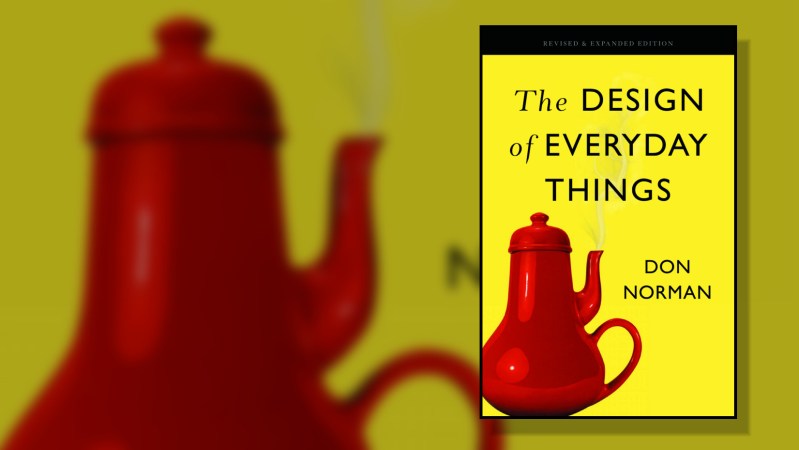
Books You Should Read: The Design Of Everyday Things
by Joshua VasquezWith everything from APIs to Raspberry Pis making it even easier for us to create and share objects shaped by personal whim, it’s high time that Don Norman’s sage design advice falls on not just the design student, but the hardware hacker and DIY enthusiast too. Grab yourself a coffee and a free weekend, and settle into the psychology of people-struggling-how-to-use-that-widget-they-just-purchased in The Design of Everyday Things: Revised and Expanded Edition.
Who’s to blame for a door that opens with a pull when everything about how it looks says it should open with a push? In Don Norman’s world, it’s not you; its the designer. Enter a world where blame is inverted and mistakes can be critically categorized. Norman takes us example by example showing us how common items in the world poorly serve the needs of their user, mainly because the designer simply ignores key aspects of our humanity. This book is a crisp, concise overview of human psychology when applied to engaging with things combined with a language of ideas to help us apply this psychology to better interactions. (And it reads like butter!)
Opening Up to the Language of Design
What’s an affordance, you might ask? Well, simply put, it’s a way that an object can be used by a human. How about a signifier? That’s a communication “signposting” scheme that object uses to suggest to you how it should be used. If that sounds a bit fluffy, just think about the last time you tried to push open a door that needed to be pulled. Something about that door was suggesting that you could push it open, but it couldn’t! It “fooled” you because all the object’s signifiers were telling you otherwise.
But Don Norman goes beyond a vocabulary that inverts our understanding of how we engage with objects and gives us another fresh perspective on how we make mistakes with out devices. Once again, these errors aren’t something to be ashamed of, but are categorizable interactions with our devices that, once understood, can be designed to accommodate or designed out altogether. Errors actually come in two large categories: mistakes and slips. Mistakes are, by and large, errors in planning, and slips are errors of action. Have you ever set your alarm for 7PM when you meant AM? That’s a slip. Or perhaps you forget some items on your grocery trip? That’s a mistake But there are actually multiple subcategories, each clearly explained with examples from real life, often accompanied by disastrous consequences that may have been preventable with different design choices. Norman’s language for understanding mistakes is precise. And with this precision, we too can unpack everyday “mistakes” into a systematic way that lets us understand why they happened and how to mitigate or prevent them.
Here lies the power of the book. It’s a grammar book, one that teaches us the language of designers. Armed with the grammar of design, we can start to see the choices of designers and start making some thoughtful design choices ourselves.
A Refresh New Look
Once you read this book, I’ll warn you. Though you may be armed with a new language, be careful with your criticism when you re-enter the world beyond that comfy armchair and empty coffee cup. Yes, in a way, this new vocabulary feels like a clever way to point a finger at “bad design.” And sure; with these new words and clearly articulated descriptions, we can do that. But let Don Norman do the blaming for you. This book is already riddled with examples of bad design drawing from either history or Norman’s personal experience. Instead, let’s put it to good use. The Design of Everyday Things is an opportunity for us as creators to reflect on how we communicate, how we suggest experiences, to the people who use our creations. So let’s make sure those experiences are good ones.
Side Note: the Revised and Expanded Edition of this book reads very differently from the original edition released way back in 1988. I strongly suggest finding the latest version if you can help it since so many of the examples have been brought up to speed with our times.